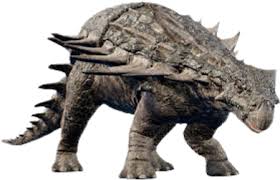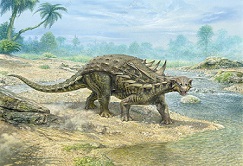
Polacanthus is a fascinating dinosaur that roamed the Earth during the Early Cretaceous period, approximately 130 million years ago. This dinosaur belongs to the group of armored dinosaurs known as ankylosaurs, characterized by their distinctive bony plates and tail clubs. Polacanthus, although not as well-known as some other dinosaurs, offers valuable insights into the diversity and adaptations of herbivorous dinosaurs during the Mesozoic Era. Let's delve into the world of Polacanthus and uncover its unique features and significance in the study of prehistoric life.
Polacanthus was first discovered in the mid-19th century in England. Its name, which means many spines, is indicative of the numerous bony plates that covered its body. Initially classified as a species of Iguanodon, it was later recognized as a distinct genus within the ankylosaur family.
| Name: | Polacanthus dinosaurs |
| Size: | Around 13-16 feet in length. |
| Main Facts: | Polacanthus, an ankylosaur, showcased early adaptations of armor and defensive weaponry, offering insights into the evolution of heavily protected dinosaurs. |
Polacanthus was a herbivore, feeding on plants such as ferns, cycads, and other vegetation that characterized the Early Cretaceous landscape. Its broad, robust jaws were adapted for grinding plant material.

Polacanthus, like all ankylosaurs, had a heavily armored body covered in bony plates called osteoderms. These plates provided protection against predators. Its most distinctive feature was a tail club, which could be used for defense.
Polacanthus lived during the Early Cretaceous, a time when dinosaurs were diversifying into various forms. It shared its environment with a range of other dinosaurs, including sauropods, theropods, and ornithopods.
Fossils of Polacanthus have been primarily found in Europe, including England and France, suggesting its presence on the continent during the Early Cretaceous.
Polacanthus contributes to our understanding of herbivorous dinosaurs and the evolution of armored adaptations. It helps researchers piece together the complex web of ecosystems during the Cretaceous period, including interactions between herbivores and potential predators.
Polacanthus, an ankylosaurid dinosaur from the Early Cretaceous, measured around 13-16 feet in length. Its body was covered in bony plates, called osteoderms, providing protection from predators. The most distinctive feature was its tail club, used for defense. Polacanthus was a herbivore, primarily consuming ferns and cycads. Fossils of this moderately sized dinosaur have been discovered in Europe, including England and France.
It offers insight into the evolution of armored dinosaurs, particularly ankylosaurs, showcasing an intermediate stage in the development of these impressive creatures. Polacanthus adds depth to our understanding of the herbivorous dinosaurs that thrived in the Cretaceous era.
Polacanthus shares typical ankylosaur characteristics with other members of its family, such as bony plates covering its body and a tail club. These traits set it apart from other dinosaur groups.
Polacanthus was a moderately sized dinosaur, measuring about 13-16 feet in length and standing roughly 4-5 feet tall at the hip. While not the largest dinosaur, it was well-armored for its size.
Polacanthus lived during the Early Cretaceous, coexisting with a variety of dinosaurs, including sauropods, theropods, and ornithopods. These contemporaries formed complex ecosystems.
Fossils of Polacanthus have been primarily found in Europe, contrasting with the distribution of some other ankylosaurs, like Euoplocephalus in North America. This demonstrates regional variations in dinosaur habitats.
Comparing Polacanthus' tail club with those of other ankylosaurs reveals variations in this defensive feature. Some had more massive, club-like tails, while Polacanthus had a less developed club.